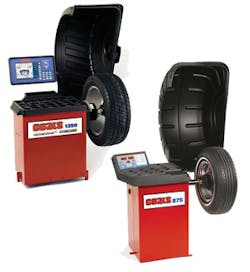Although tire and wheel specialty shops tend to see higher volumes of wheel balancing, any independent shop should make balancing options available to customers. Even entry-level balancers now have more mid-range and premium features, making the world of wheel balancing faster and more intuitive — even for the most general repair shop.
Aside from selling the main equipment, there are other opportunities with wheel balancers. Even if shops have all the necessary equipment, find out if they need upgrades on accessories.
“A simple visual inspection of the cones, shafts and nuts make it obvious to even an untrained eye that the parts should be replaced,” said Bruce Hartin, president of Haweka.
Manual to automatic
Wheel balancing systems have developed from complete manual operation to fully automatic, and both are still used today. Kevin Keefe, VP of marketing for Hennessy Industries, explained some of the differences.
“You have fully manual machines that the technician has to manually punch in the distance, diameter and width measurements,” he said. “You’ve got what we call 2D machines, which give you distance and diameter automatically, using the data-entry arm.
“Then you’ve got 3D units, which are accomplished a couple different ways. We use a sensor in the hood. Other manufacturers use a second data-entry arm, where you can capture the width automatically.”
Many wheel balancing units today offer multiple automatic features, including automatic distance arms.
“Before, you had to physically make some measurements and then plug them into the wheel balancer,” said Andrew Randall, CEMB-USA product manager. “Now, when you take the measurement (with the automatic distance arm), it electronically feeds the measurement straight into the balancer.”
The number of balances done per shop helps determine the entry-level vs. premium balancer a shop needs. In general, though, shops continue to buy units with what used to be considered high-end features, based on the functionality and longevity of the unit.
“Some of those features that used to be really just on premium machines, over the last three or four years have migrated into mid-range, and even on some, entry-level models,” said Keefe.
“Overall, what we’re seeing is a movement toward value. Just across segments what we’ve seen is users becoming more conscious of what they’re getting for their money. They’re not jumping up to the premium units. They’re not valuing some of the premium functionality, like diagnostics, as much as they were, say, two or three years ago.”
The world of accessories
If a shop already has a functioning, up-to-date wheel balancer, you can always upsell with accessories. Two types of accessories exist for shops that currently have wheel balancers: upgrades and replacements.
If shops aren’t looking to upgrade, or don’t have a high volume of tire work coming through the shop, look to offer replacement parts for current equipment.
Haweka, in particular, only makes balancer accessories as add-ons for current shop equipment.
“Certainly getting started on a tool truck, (distributors) want to go after the cones, the quick nuts and the shaft (accessories), because those are pretty simple to eyeball and say, ‘Look, you need to replace this problem with your wheel balancer,’ ” said Hartin. “It’s inexpensive and a great way for them to get their feet wet.”
Beyond simple replacements, companies like Haweka offer additional accessories to upgrade existing units. Quick plates offer users an add-on to align the balancer with bolt holes of the wheel, eliminating the need for wheel charts. The quick plates allow technicians to mount a variety of different wheels without additional measurements.
Upgrades
Distributors who want to branch out into wheel balancer upgrades can offer demonstrations of the product to different shops, said Hartin.
Additional upgrades include kits for custom wheels as well as light truck and SUV applications, to customize wheel balancers for use on less common types of wheels.
“Any balancer on the market today comes with the basic accessories you need to do most OE passenger car work. When you get into custom wheels or light truck wheels, there are some additional accessories that would either be necessary, or very beneficial,” said Keefe.
“For custom wheels, we highly recommend some type of pin plates, also known as flange plates, which are used to center the wheel using the lug holes rather than the center hole. … (For) light truck wheels, you basically need larger cones and a backing plate, for those larger assemblies.”
Keefe also explained the different types of adapters available for balancers.
“There are a number of other specialty adapters. There are short cones and in-between cones, for certain wheel designs, and certain hub-bore designs that don’t lend themselves to very accurate or repeatable balancing using standard passenger car cones. There are also offset adapters and specialty chucks for doing some of your larger light-truck assemblies that improve accuracy and repeatability, and reduce comebacks related to improper mounting.”
For wheel balancers, you don’t need to focus on just the capital equipment sale. Inspect each shop for old and worn equipment and look to offer upgrades and accessories to expand their tire business.
PTEN Buyers Guide
See more tire and wheel service equipment in the PTEN Buyers Guide.


